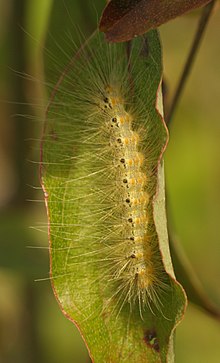美国白蛾
| 美国白蛾 | |
|---|---|

| |
| 科学分类 | |
| 界: | 动物界 Animalia |
| 门: | 节肢动物门 Arthropoda |
| 纲: | 昆虫纲 Insecta |
| 目: | 鳞翅目 Lepidoptera |
| 总科: | 夜蛾总科 Noctuoidea |
| 科: | 裳蛾科 Erebidae |
| 属: | 白蛾属 Hyphantria |
| 种: | 美国白蛾 H. cunea
|
| 二名法 | |
| Hyphantria cunea (Drury, 1773)
| |
| 异名[1] | |
| |
美国白蛾(学名:Hyphantria cunea)是裳蛾科白蛾属下的一种蛾,幼虫会在夏末和秋季织网状巢,又名秋幕毛虫[2]。是国际自然保护联盟公布的百大外来入侵物种之一,以几乎所有种类的落叶树叶子为食,对东亚造成的虫害仅次于松材线虫[3]。这种蛾的成年体对植物威胁不大,并以其美观著称。
分布
[编辑]美国白蛾原生于北美洲从加拿大到墨西哥的广大地域内,是很少的几种被引进到其他大陆的昆虫之一——在1940年代它被引入南斯拉夫,[4],现在从法国到里海的欧洲大陆上都有其踪迹。1990年至1993年进入土库曼斯坦,1996年至1997年进入乌兹别克斯坦。1945年被引入日本,1979年在中国辽宁省出现。[5] 现在蒙古、韩国和俄罗斯滨海边疆区都有其踪迹,因此也被认为是全北区分布的。
生命周期
[编辑]
北美洲的一些成虫一年只出现一拨,幼虫则而出现在夏末到早秋季节,不过北纬40度地区一年可能出现两拨成虫,越靠南的地方幼虫的网出现也越早。[6]
幼虫
[编辑]成年美国白蛾在树叶背面产卵,[7] 卵在一个星期之后就会孵化。[8]
幼虫的颜色有很多,从浅黄色到深灰色不等,有黄色斑点和毛刺。[6] 身体两侧有乳白色条纹。[8] 其长度最大可达35毫米(1.4英寸)。幼年体只吃叶子表面,成熟体则会食用整个叶子。整个幼虫阶段约四至六星期。[8]
蛹
[编辑]变成蛹的幼虫会挂在树皮上或落在树下的落叶层中过冬,蛹呈深褐色,长约10毫米(0.39英寸)。其茧则是浅褐色的,由幼虫吐出的丝制成。[8]
成年体
[编辑]有一些美国白蛾全身几乎都是白色的,但有的也会在前翅上有黑色或褐色斑点。[7][8] 成体多毛,前腿上有黄色斑块。后翅较不明显,腹部有褐色绒毛,翼展约35—42毫米(1.4—1.7英寸)。
食物
[编辑]美国白蛾以几乎所有种类的落叶树叶子为食,被其侵袭的植物可能会脱叶。全世界有记录的美国白蛾食用植物有636种。[9]
防治
[编辑]通过定期喷洒药物灭杀、人工监测捕捉以及释放周氏啮小蜂可有效遏制美国白蛾扩散与繁殖。
图片
[编辑]-
雄性
-
雌性
-
柳树上的网
-
美国白蛾啃食过的叶槭
参考文献
[编辑]- ^ Hyphantria cunea (Drury, 1773). GBIF. Copenhagen, Denmark: GBIF Secretariat. [2024-10-14].
- ^ 王雅娜; 于艳雪,田茜,张柳,李红卫,杨硕,翟俊峰. 基于RPA-CRISPR/Cas12a的美国白蛾可视化快速检测新方法. 环境昆虫学报. 2024, 46 (5): 1051–1058 [2024-10-14].
- ^ 存档副本. [2015-08-03]. (原始内容存档于2019-04-18).
- ^ Carlos Lopez-Vaamonde, David Agassiz, Sylvie Augustin, Jurate De Prins, Willy De Prins, Willy De Prins, Stanislav Gomboc, Povilas Ivinskis, Ole Karsholt, Athanasios Koutroumpas, Fotini Koutroumpa, Zdeněk Laštůvka, Eduardo Marabuto, Elisenda Olivella, Lukasz Przybylowicz, Alain Roques, Nils Ryrholm, Hana Sefrova, Peter Sima, Ian Sims, Sergey Sinev, Bjarne Skulev, Rumen Tomov, Alberto Zilli, David Lees. Lepidoptera. Chapter 11. BioRisk. 2010-06-07, 4: 603–668 [2018-04-02]. ISSN 1313-2652. doi:10.3897/biorisk.4.50. (原始内容存档于2018-06-02) (英语).
- ^ Gomi, Takeda. Changes in life-history traits of Fall Webworm within half a century of introduction into Japan.. Functional Ecology. 1996,. 10:384-389.
- ^ 6.0 6.1 Wagner, DL. Caterpillars of Eastern Forests. Princeton, NJ: Princeton Univ. Press. 2005.
- ^ 7.0 7.1 Douce, GK. "The Fall Webworm" (页面存档备份,存于互联网档案馆). Accessed August 21, 2006.
- ^ 8.0 8.1 8.2 8.3 8.4 Hyche, LL. "Fall webworm: A Guide to Recognition and Habits in Alabama" (页面存档备份,存于互联网档案馆). Accessed August 21, 2006.
- ^ Warren, LO and M Tadic. The fall webworm, Hyphantria cunea (Drury). Arkansas Agric. Exp.Sta. Bull. 1970.
参考书目
[编辑]- Bat Man, 2003. The fall webworm . Accessed Aug 21, 2006.
- Gomi, T and M Takeda. 1996. Changes in life-history traits of Fall Webworm within half a century of introduction into Japan. Functional ecology 10:384-389.
- Hyche, LL, 1999. Fall webworm: A guide to recognition and habits in Alabama (页面存档备份,存于互联网档案馆) Accessed Aug 21, 2006.
- Wagner, DL. 2005. Caterpillars of eastern forests. Princeton Univ. Press.
- Warren, LO and M Tadic. 1970. The fall webworm, Hyphantria cunea (Drury). Arkansas Agric. Exp.Sta. Bull. 759.
外部链接
[编辑]- Bagworm, Fall Webworm or Eastern Tent Caterpillar? August 18, 2001. Sandra Mason, University of Illinois Extension. Accessed May 31, 2010.
- U. Mass site (页面存档备份,存于互联网档案馆)
- U. Georgia site
- Ohio State U. site
- Texas A&M site
- Fall webworm (页面存档备份,存于互联网档案馆) on the UF / IFAS Featured Creatures Web site




